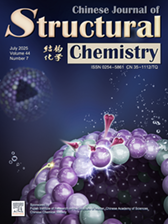
Cover Picture
Neodymium-doped hollow Ir/IrO2 nanospheres with low geometric iridium density enable excellent acidic water oxidation performance
Xiaoqian Wei, Hanyu Gao, Tiantian Wang, Zijian Li, Yanru Geng, Guiping Zheng, Min Gyu Kim, Haeseong Jang*, Xien Liu*, Qing Qin* Submit a Manuscript
Neodymium-doped hollow Ir/IrO2 nanospheres with low geometric iridium density enable excellent acidic water oxidation performance
Xiaoqian Wei, Hanyu Gao, Tiantian Wang, Zijian Li, Yanru Geng, Guiping Zheng, Min Gyu Kim, Haeseong Jang*, Xien Liu*, Qing Qin* Submit a Manuscript
Photomechanical movements of a coordination polymer-based composite enable a reversible photocontrollable electrical switch
Qian Ren, Shu-Fen Zhang, Dong Liu*, Jian-Ping Lang*
Chin. J. Struct. Chem., 2025, 44(7), 100622. DOI: 10.1016/j.cjsc.2025.100622
July 1, 2025
Coordination polymer; Photocycloaddition reaction; Composite film; Photomechanical movements; Electrical switch
ABSTRACT
Flexible circuit switches have been widely used in electronic devices due to their outstanding flexibility and operability. In order to expand the types of flexible circuit switch materials, we develop a unique composite material, which integrates a photoresponsive flexible substrate derived from a photoreactive coordination polymer (CP) with an elastic conductive adhesive tape (CAT) in this work. The photoreactive CP {[Cd(2,6-bpvn)(3,5-DBB)2]·DMF}n (1) is prepared through solvothermal reaction of Cd(NO3)2·4H2O with 2,6-bis((E)-2-(pyridin-4-yl)vinyl)naphthalene (2,6-bpvn) and 3,5-dibromobenzoic acid (3,5-HDBB). Upon irradiation with UV light, crystals of 1 can undergo [2+2] photocycloaddition reaction and exhibits photomechanical movements. The crystalline powder of 1 can be uniformly distributed in polyvinyl alcohol (PVA) to generate the composite film 1-PVA. After pasting a piece of CAT on the surface of a 1-PVA film, a conductive two-layer film of 1-PVA/CAT can be fabricated. This film bends rapidly upon UV light exposure, connecting the circuit and causing the bulb to light up. When the light source is removed, it reverts to its initial state and the circuit is disconnected and the bulb is extinguished. This process can be cycled at least 100 times, achieving precise turn-on and turn-off performances of the photocontrollable circuit switch.







